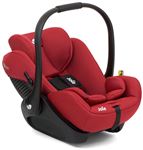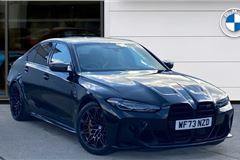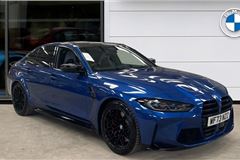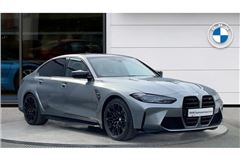December 2013
BMW unveils M3 Saloon
It's powered by a high-revving, 3.0-litre six-cylinder in-line engine with M TwinPower Turbo technology has been specifically developed for this purpose, and produces a maximum output of 431hp. Its peak torque of 550Nm is available across a very wide rev range starting at just 1850rpm.
The standard sprint from 0-62mph takes 4.3 seconds with manual transmission, or just 4.1 seconds with the optional M DCT, while the top speed is 155mph (electronically limited). The new powerplant also boasts excellent fuel economy: the combined consumption in the EU cycle is as high as 34mpg and CO2 emissions are as low as 194g/km.
To maximise dynamic ability and ensure excellent efficiency, a weight loss of over 80kgs has been achieved compared to a comparably equipped predecessor model. Specific weight-saving measures include the increased use of lightweight materials: both models now feature a carbon-fibre reinforced plastic roof.
The standard transmission specified is a six-speed manual gearbox which uses innovative new carbon friction linings in its synchroniser rings. The gearbox blips the throttle on downshifts - previously a feature reserved for the M Double Clutch Transmission - improving the smoothness of the driving experience and helping to enhance stability.
The optional transmission is the third-generation M Double Clutch Transmission (M DCT). As well as changing gear automatically, in manual mode it enables ultra-fast gear changes with no interruption in the flow of power. The integrated Launch Control function ensures optimum sprinting performance off the line. In addition, the system allows for a range of extra features, including Stability Clutch Control, which opens the clutch when the car is understeering to bring it back into line, and also the selectable Drivelogic modes that give the BMW M3 more comfortable, more economy-focused or even sportier characteristics depending on driver choice.
The Active M Differential makes a considerable contribution to the dynamics. With further weight-savings thanks to hollow, and hence lighter, output shafts, the Active M Differential uses an electronically controlled multi-plate limited-slip differential to optimise traction and directional stability.
The electromechanical steering system represents a new development from BMW M. The integrated M Servotronic function electronically adjusts the level of steering assistance according to the car’s speed. The system offers the driver three settings as standard, which can be selected at the touch of a button: COMFORT, SPORT and SPORT+ modes allow the level of steering assistance to be adapted to suit any given situation and the driver’s personal tastes.
The standard new BMW M Compound brakes boast impressive feel, outstanding stopping power and a high resistance to fade. Far lighter than conventional equivalents, they contribute to a substantial reduction in unsprung masses. Even lighter BMW M Carbon ceramic brakes can be specified as an option - gold callipers denote their fitment.
Standard equipment includes technical features such as Adaptive M suspension, 19-inch M light alloy wheels and front and rear PDC; comfort items such as the heated and electric BMW M seats and exterior-folding mirrors; aesthetic features such as High-gloss Shadowline exterior trim and finally the full BMW Professional Media package with upgraded Bluetooth system.
The bespoke front seats take inspiration from the bucket seats fitted in racing cars, and feature a full-size single-piece back panel. This means the construction of the seats is very flat, while the high, width-adjustable side bolsters and low-set seat surface allow an ideal seating position and provide excellent support. Despite this, these BMW M seats also include electric adjustment and heating as standard. On the seat surface, the stitching, upholstery segmentation and perforation lend the seats a slim-fitting feel, whilst the BMW M logo on the seat is illuminated for the first time.
| Model |
Power (hp) |
Torque (Nm) |
0-62mph (secs) |
Top speed (mph) |
Combined (mpg) |
CO 2 emissions (g/km) |
| BMW M3 Saloon |
431 |
550 |
4.3 (4.1) |
155* (155*) |
32.1 (34.0) |
204 (194) |
June 2016
BMW M3 30 Jahre Special Edition launched
Limited in the UK to only 30 cars, the M3 30 Jahre Edition builds on the Competition Package which is available for the BMW M3. The Competition Package comprises an increase in engine output by 19PS to 450PS and a combined fuel consumption of 34mpg with 194 g/km CO2 emissions. A
lso included on this model is the Adaptive M suspension, which has been comprehensively aligned to the increased performance. Optimised features also include new springs, dampers and stabilisers, modified characteristic curves of the three modes COMFORT, SPORT and SPORT+ as well as a correspondingly modified standard Active M differential on the rear axle and Dynamic Stability Control feature (DSC).
| Model |
Power
Hp |
Torque
Nm |
0 – 62mph
Seconds |
Top Speed
Mph |
Combined
Mpg |
CO 2 Emissions
g/km |
| M3 30 Jahre Edition |
450 |
550 |
4.0 |
155* |
34.0 |
194 |
This special edition model features a high standard specification including harman/kardon surround-sound system with a total of 16 speakers. In addition to the exclusive content this car it also features as standard such equipment as Adaptive LED Headlights, BMW M Carbon Ceramic braking system, BMW M Head-up display, BMW M Double-Clutch Transmission, Comfort Access, Surround View, Comfort Access, Advanced Parking Pack, Extended Storage and a Speed Limit Display.
Priced at £82,675 OTR, the BMW M3 30 Jahre Edition goes on sale in Summer 2016, this being exactly 30 years after the signing of the first contract for the purchase of a BMW M3 – the original version of the car having made its debut at the 1985 Frankfurt Motor Show.
November 2017
BMW M3 CS launched
Power for the latest special vehicle to come out of BMW M GmbH is from a six-cylinder in-line engine – a configuration of which has a long tradition at BMW – and one that ensures the absolute best performance in the new BMW M3 CS. Compared to the M3 with Competition Package, the maximum power has been increased by 10PS.
The maximum torque of 600Nm is about 10 per cent higher (M3 with Competition Package: 550Nm) and is available from 4,000rpm to 5,380rpm. The power output gives the BMW M3 CS performance on a par with supercars, with the sprint from zero to 62mph taking just 3.9 seconds. Thanks to the M Drivers Package, the maximum speed is limited to 174mph.
A standard unique feature for the CS are forged light-alloy wheels, finished in Matt Orbit Grey. The ten-spoke design is based on the wheels of the successful M4 racing cars from the German Touring Car Masters (DTM).

 What is your car like to live with?
What is your car like to live with?

.jpg?width=640&height=426&rmode=crop)
.jpg?width=640&height=426&rmode=crop)
.jpg?width=640&height=426&rmode=crop)
.jpg?width=640&height=426&rmode=crop)
.jpg?width=640&height=426&rmode=crop)
.jpg?width=640&height=426&rmode=crop)
.jpg?width=640&height=426&rmode=crop)


 Twin turbo 3.0-litre straight six engine with 430PS. More powerful, quicker yet more economical than before. Impressively forgiving ride. Phenomenal grip in the dry.
Twin turbo 3.0-litre straight six engine with 430PS. More powerful, quicker yet more economical than before. Impressively forgiving ride. Phenomenal grip in the dry.
 Lacks the V8 sound of the previous M3.
Lacks the V8 sound of the previous M3.
.jpg?width=240&height=160&rmode=crop)

.jpg?width=240&height=160&rmode=crop)

.jpg?width=240&height=160&rmode=crop)




